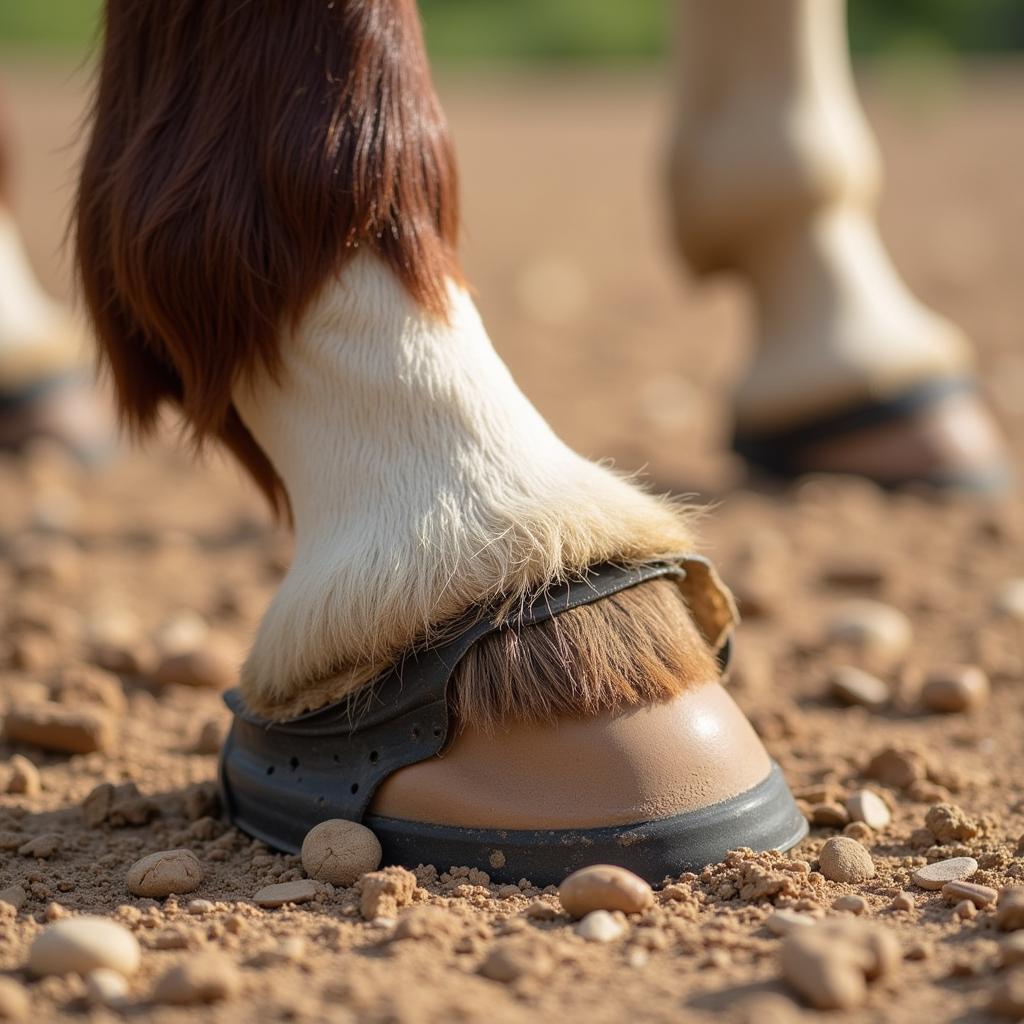Horse Shoe Pads are an essential part of equine hoof care, providing a crucial layer of protection and support. Whether you’re a seasoned horse owner or just starting out, understanding the nuances of horse shoe pads can significantly impact your horse’s comfort and performance. This comprehensive guide will delve into the world of horse shoe pads, covering everything from the different types available to how to choose the right ones for your horse’s specific needs.
Choosing the correct horse shoe pads can prevent a multitude of hoof problems, including bruising, abscesses, and even navicular disease. Just as humans benefit from supportive footwear, horses rely on proper hoof protection to stay sound and comfortable, especially when working on various terrains. From the soft ground of a riding arena to the rocky trails of a mountain path, the right horse shoe pads can make all the difference. Think of them as customized insoles for your horse’s shoes, providing tailored support and cushioning where it’s needed most.
Types of Horse Shoe Pads and Their Uses
There’s a wide variety of horse shoe pads on the market, each designed for a specific purpose. Understanding the differences between them is key to selecting the best option for your horse. Some common types include:
- Leather Pads: Known for their natural shock absorption and breathability, leather pads are a popular choice for horses with sensitive feet. They conform well to the hoof and provide a comfortable layer of protection.
- Rubber Pads: Durable and versatile, rubber pads offer excellent cushioning and help to reduce concussion on hard surfaces. They come in various thicknesses and densities to accommodate different needs.
- Polyurethane Pads: These pads are known for their shock-absorbing properties and ability to distribute pressure evenly across the hoof. They are also relatively lightweight and easy to maintain.
- Felt Pads: Primarily used for therapeutic purposes, felt pads provide excellent cushioning and can be impregnated with medications to treat hoof conditions.
Choosing the Right Horse Shoe Pads for Your Horse
Selecting the appropriate horse shoe pads depends on several factors, including your horse’s breed, discipline, and individual hoof conformation. You should also consider the terrain your horse works on and any existing hoof problems. Consult with a farrier or equine veterinarian for personalized recommendations. Here at Justus Horses USA, we understand that choosing the right horse shoe pads can be overwhelming. That’s why we offer expert advice and a wide selection of high-quality horse shoeing box and things you need for horses.
What are the signs that my horse needs new pads?
One clear indicator is excessive wear and tear on the existing pads. If the pads are significantly thinned, cracked, or deformed, it’s time for replacements. Also, pay attention to your horse’s behavior. Signs of discomfort, such as stumbling, short strides, or reluctance to work, can indicate a problem with the pads or shoes.
 Horse hoof with a newly applied shoe and pad
Horse hoof with a newly applied shoe and pad
How often should horse shoe pads be replaced?
Generally, horse shoe pads should be replaced every time the horse is shod, which is typically every four to six weeks. However, the frequency may vary depending on the individual horse’s needs and the type of pads used.
“Regular hoof care is crucial for maintaining your horse’s overall health and soundness,” says Dr. Emily Carter, DVM, an equine veterinarian with over 20 years of experience. “Choosing the right horse shoe pads is an important part of this care and can significantly improve your horse’s comfort and performance.”
Caring for Horse Shoe Pads
Proper maintenance can extend the life of your horse shoe pads and ensure they continue to provide optimal protection and support. Regularly clean the hooves and pads to remove dirt, debris, and packed material. This helps to prevent thrush and other hoof infections. Inspect the pads for any signs of wear and tear and replace them as needed.
Conclusion
Horse shoe pads are an essential investment in your horse’s well-being. By understanding the different types available and choosing the right ones for your horse’s individual needs, you can help ensure their comfort, performance, and longevity. Remember to consult with a farrier or equine veterinarian for personalized advice. At Justus Horses USA, we’re committed to providing you with the knowledge and resources you need to care for your equine partner. Visit our website to explore our wide selection of high-quality horse care products, including thin soles on horses solutions and top horse wear brands. Properly fitted horse shoe pads are vital for your horse’s health and can prevent numerous hoof problems.
FAQ
- What are the benefits of using horse shoe pads?
- How do I know what size horse shoe pads my horse needs?
- Can I change my horse’s shoe pads myself?
- What are some common problems associated with ill-fitting horse shoe pads?
- Are there horse shoe pads specifically for therapeutic purposes?
- How can I tell if my horse’s shoe pads are worn out?
- What materials are horse shoe pads made of?
Johnathan Fitzwilliam, a renowned farrier with over 3 decades of experience, adds, “A well-maintained hoof, complete with the appropriate shoe and pad, is a testament to a responsible horse owner.”
When you need support, don’t hesitate to contact us. Phone: 0772127271, Email: [email protected] Or visit our address: QGM2+WX2, Vị Trung, Vị Thuỷ, Hậu Giang, Việt Nam. We have a 24/7 customer service team.